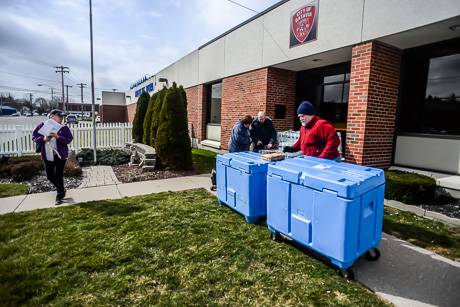
There is dry ice and water available at the fire hall on Evans Street.
The National Grid workers handing out the dry ice advise that you should bring a cooler with you. If you don't have a cooler, bring blankets to wrap the ice in. If you don't have a cooler, you need to be prepared to drive home with your windows open because of the CO2 the dry ice emits. When you get the block, you need good winter gloves to handle the ice.
The crew was also told they should expect to be back at the fire hall tomorrow, which sounds like a sign that National Grid expects a lot of people to still be without power through tonight.

Dry ice needs to be handled
Dry ice needs to be handled with care. Its temperature as a solid is minus 103 degrees F. It should not be handled with bare hands. As it "melts," it actually sublimates, going directly to gaseous CO2. In a confined space it could cause asphyxiation. It can also pressurize any container it is in. Special caution should be taken not to get dry ice in the eyes. A face shield should be used when handling dry ice pellets or breaking up blocks.
If using dry ice in a cooler
If using dry ice in a cooler best to use it as a wet ice extender. Wrap the dry ice in newspaper and put a 25 lb. block of regular ice on either side of it. Don't put food directly on the dry ice unless you want it to freeze.
NPR (National Public Radio)
NPR (National Public Radio) had a segment on one day, where they used super-sensitive mics, to audio-record the "screams" made by different metal objects being placed on dry ice.
They also used objects made from different metals - a copper penny, a silver quarter, a stainless steel bread knife, a cobalt drill bit, etc.
The instantaneous contraction of the different metals produced some very eerie sounds (Scientists study some really odd stuff, don't they?).
For you backyard-scientists out there, there's a husband/wife team, Dan and Denise Rojas, down here in Tampa (FL). They have (both) a website at greenpowerscience.com , and, a YouTube channel ( greenpowerscience), showing how to "harness" the power of the sun.
Example: Dan shows/explains how to take one of those old TV "screens" from the 80's (the 3' x 4' rear-projective TV types) and convert it into a homemade Fresnel lens - capable of reaching 3000º, hot enough to melt steel, glass, and even solid rock.
Another one shows how to take a garbage can lid and a Mylar reflective "rescue" blanket (costs about $10), and make a concave solar reflector.
Or, how about stretching some clear plastic film over a homemade frame, then, putting several gallons of water in it. When the sun shines through it, it creates a focal point that will ignite a piece of wood.